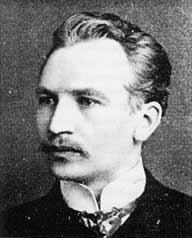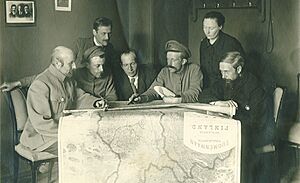Kullervo Manner facts for kids
Quick facts for kids
Kullervo Manner
|
|
|---|---|
 |
|
| Chairman of the Finnish People's Delegation of the Finnish Socialist Workers' Republic | |
| In office 29 January 1918 – 25 April 1918 |
|
| Preceded by | Position established |
| Succeeded by | Position abolished |
| Speaker of the Parliament | |
| In office 4 April 1917 – 31 October 1917 |
|
| Preceded by | Kaarlo Juho Ståhlberg |
| Succeeded by | Johannes Lundson |
| Leader of the Finnish Communist Party | |
| In office 1920–1935 |
|
| Preceded by | Yrjö Sirola |
| Succeeded by | Hannes Mäkinen |
| Leader of the Finnish Social Democratic Party | |
| In office 1917–1918 |
|
| Preceded by | Matti Paasivuori |
| Succeeded by | Väinö Tanner |
| Personal details | |
| Born |
Kullervo Achilles Manner
12 October 1880 Kokemäki, Grand Duchy of Finland, Russian Empire |
| Died | 15 January 1939 (aged 58) Ukhta-Pechora, Russian SFSR, Soviet Union |
| Political party | SDP SKP |
| Spouse | Olga Arjanne |
Kullervo Manner (born October 12, 1880 – died January 15, 1939) was an important Finnish and Soviet politician. He was one of the main leaders of the Finnish Socialist Workers' Republic.
Manner was a member of the Finnish parliament. He even served as its Speaker in 1917. He also led the Social Democratic Party of Finland from 1917 to 1918. During the Finnish Civil War, he led the Finnish People's Delegation. This group was a leftist alternative to the official Finnish government. After the war, he moved to the Soviet Union. There, he helped start the Finnish Communist Party. Some say if his side had won the Civil War, he might have become the "Leader of the Red Finland."
Contents
Early Life & Political Beginnings
Growing Up in Finland
Kullervo Manner was born in Kokemäki, Finland. His father was a minister. His mother was Alma Limón. After finishing high school in 1900, Manner became a journalist. He worked in Porvoo and later in Helsinki.
In 1906, he started a newspaper called Työläinen, which means "worker." He was its main editor until 1909. An article in his newspaper led to a six-month prison sentence for him in 1911. This was for a crime against the ruler, Nicholas II.
Joining the Parliament
Manner was elected to the Finnish Parliament in 1910 and again in 1917. He represented the Social Democratic Party of Finland. In 1917, he was chosen as the Speaker of the Parliament. This was a very important position. His brother, Arvo Manner, also became a governor in Finland later on.
Marriage and Work
Kullervo Manner married Olga Arjanne in 1908. They both worked at the Työläinen newspaper. They even lived in the same building as the newspaper's office.
Role in the Finnish Civil War
Leading the Red Side
The Finnish Civil War began in January 1918. On January 28, Kullervo Manner was chosen to lead the Finnish People's Delegation. This group represented the socialist side, also known as the "Reds."
By April 1918, Manner became the commander-in-chief of the Red Guards. He was also made the head of their short-lived government. He was given special powers to make decisions.
The Two Sides of the War
During this time, the Red Guards controlled cities like Helsinki and other areas in southern Finland. Meanwhile, the White Guards controlled northern Finland. They were led by General Mannerheim and the official Finnish government.
Life in the Soviet Union
Founding the Communist Party
After the Civil War ended, Manner left Finland. He went to Soviet Russia. There, he became the second leader of the Finnish Communist Party. He also worked for the Comintern, an international organization that promoted communism.

Difficulties and Arrest
In the 1930s, Manner and his wife, Hanna Malm, faced problems with another leader, Otto Wille Kuusinen. Manner lost most of his jobs in May 1934. He continued to work as a reporter for the Comintern until July 1935.
In 1935, Manner was arrested. He was sentenced to ten years of hard labor. He was sent to a Gulag, which was a labor camp, in Ukhta-Pechora in Russia.
Death and Later Recognition
Kullervo Manner died in the labor camp on January 15, 1939. The official reason for his death was tuberculosis. However, some historians believe he might have died from radiation sickness. This could have happened because he worked with water that contained radium.
Years later, in 1962, Manner was officially "rehabilitated." This means the Soviet government admitted that his punishment was wrong.
See also
- Eero Haapalainen
- Otto Wille Kuusinen
- Red Finland
Sources
- Veli-Pekka Leppänen: Herraspojan harharetki päättyi joukkohautaan Uralilla (in Finnish) – Helsingin Sanomat, July 18, 2017. Retrieved September 27, 2021.

